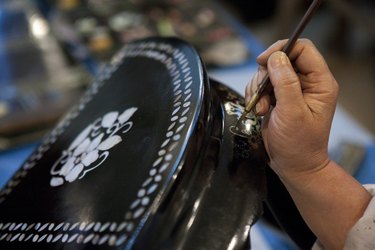
Lacquering has been an art form in the Orient since 5,000 B.C., but traditional lacquers are very different from the ones you purchase in spray cans today. They are derived from sap that oozes from a variety of trees in the sumac family, and they contain the same irritant — urushiol — that is found in poison oak, poison sumac, and poison ivy. The sap is traditionally harvested by specialists with immunity to urushiol, but once the lacquer dries, the irritant is no longer active.
All this is to say that restoring Chinese lacquer furniture, bowls, or other keepsakes involves more than simply applying new lacquer unless you live in Asia and have access to the authentic traditional product. This isn't because conventional lacquer won't work. It might, but if you do it wrong, there will be no way to fix the mistake, so it's better to try other options first. If it turns out that applying more lacquer is the only option, you're better off having a pro do it than to risk ruining the finish altogether.
Video of the Day
Video of the Day
Fixing Spills and Stains
A lacquer finish is hard and generally waterproof, but it can stain and get marred by stuff you drop on it. In most cases, the repair is easy, but you should never use a strong solvent, like acetone (nail polish remover) or lacquer thinner to remove it or you'll damage the finish. Here's how to remove some of the most common stains and sticky stuff:
- Candle wax or chewing gum: Put ice on it to harden it and scrape it off gently with a plastic paint scraper.
- Grease: Blot as much as you can with an absorbent cloth. Then saturate the area with mineral spirits, sprinkle talcum powder, and blot again. Repeat until the stain is gone.
- Alcohol: Remove alcohol spots by rubbing with paste wax or a rag slightly moistened with ammonia. If the spots are old, make a paste with rottenstone and linseed oil and rub that in with a soft cloth.
- Paint: Remove fresh paint with liquid solvent-based wax. If the paint has hardened, cover it with boiled linseed oil to soften it and then rub it off with a cloth dampened with linseed oil.
Fixing Cracks and Scratches
It's easy to heal cracks and scratches on a conventional lacquer finish by simply applying more lacquer. Since the repair might not blend if you do that on Oriental lacquer, you may have to settle for hiding the defects rather than healing them.
One way to do this is to polish the defects with furniture wax. Rub the wax in a circular motion using a soft cloth, let it dry, and then remove any white residue from cracks with turpentine and an old toothbrush. As a wax alternative, you can break open a Brazil nut, black walnut, or butternut and rub the meat onto the defect. You can also use store-bought walnut oil. If the crack remains visible after this treatment, use a brown or black crayon to color it in.
White Rings and Blotches
White discoloration in a lacquer finish is usually caused by moisture that has seeped below the surface. One of the traditional methods to leach out the moisture is to cover the area with olive oil or mayonnaise that contains olive oil. The oil seeps into the finish and replaces the water, and after about 24 hours, the stains should be gone.
For more immediate results, rub the affected areas with a solution consisting of equal parts turpentine, linseed oil, and vinegar. You can also try covering the spots with a towel and pressing a warm iron onto it for about 30 seconds. The heat vaporizes the water so it can escape.